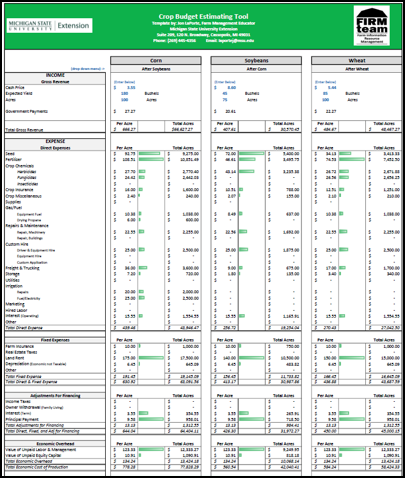Lessons learned from the 2019 season part 2
This article will focus on the cost of production.

Often times, the real factors driving the risks or concerns on the farm are largely unknown or not immediately understood. This was often the case last year, as we experienced a lot of uncertainty and unknowns that influenced the decisions made by many farm managers. Many of those situations were benefited by those farms who had a good understanding of their operation’s cost of production.
The phrase “cost of production” is commonly thought to focus almost exclusively on operating activities. This is often narrowed even further to what specifically went into raising livestock or producing a crop. Producers focus on yield and the profitability generated by that production, which is what drove many of the decisions made this past year. However, if operating activities are the only focus, then we start to make decisions without looking at all the pieces. This coincides with the first article of our series, when making decisions using just the information in a farm’s IRS tax returns.
While it certainly takes into account the activities from the farm’s production, a complete review of a farm’s cost of production looks at other activities as well (i.e. fixed, financing, opportunity, etc.). Looking at all activities allows producers to understand which ones add or take away from the farm’s income. It also begins to reveal where the concerns or risks really are and, most importantly, what steps or actions can be taken to minimize their potential impact.
This is also another benefit of the financial analysis. It provides the starting point to begin identifying potential risks through an “enterprise analysis.” An enterprise refers to each individual production area within the farm. An analysis begins by separating out incomes and expenses for each production area. Once everything is allocated to an individual enterprise, we can look at the specific risks or concerns that need to be addressed in order for each one to be successful.
The key is being able to look at the details of each enterprise and understand whether the information you’re seeing should be a concern or considered reasonable for that production area. One of the best ways to determine if there’s an area of risk is to compare the farm’s cost of production against farms of similar size. Each year MSU Extension Telfarm publishes a benchmarking report that provides a comparison of similar size farms across Michigan. Another resource is the Farm Financial Management Database (FINBIN) through the University of Minnesota. The FINBIN database is a collection of benchmarking reports from across the Midwest for farms to compare against. MSU is a partner and contributor to the database project.
Once risks are identified, we can think about potential changes to make in order to eliminate or at least minimize their impacts. If fertilizer costs are too high, can we achieve the same or similar yields with a different fertilizer plan? Or, if weed resistance could be a major concern, how does the cost of different chemical programs impact the farm’s bottom-line? Comparison of the enterprise analysis to other benchmarks can also help to determine if the risks are even within the farm’s ability to manage.
 Finally, once we have identified our risks and our intentions to address them, we organize them into a plan of action. This is our guide for the direction we’ll take the farm in the next year and help consider what resources are needed. Do we have the materials or the knowledge to make our intended changes? If not, where can we get them or who can we enlist to help us address our risks? Most importantly, does this plan have the same potential to be profitable as the farm has been in past years?
Finally, once we have identified our risks and our intentions to address them, we organize them into a plan of action. This is our guide for the direction we’ll take the farm in the next year and help consider what resources are needed. Do we have the materials or the knowledge to make our intended changes? If not, where can we get them or who can we enlist to help us address our risks? Most importantly, does this plan have the same potential to be profitable as the farm has been in past years?
One tool that can help look at the potential profitability is the Crop Budget Estimator Tool available through MSU Extension. This is a Microsoft Excel based tool designed for producers to use their own records in building a budget that can be used for marketing decisions, comparing chemistry and fertilizer programs, evaluating capital purchases and other important farm management decisions.
Knowing what our cost of production was last year helps build the plan toward a better next year. It also leads to the next stop on our roadmap: Break-evens.



 Print
Print Email
Email




